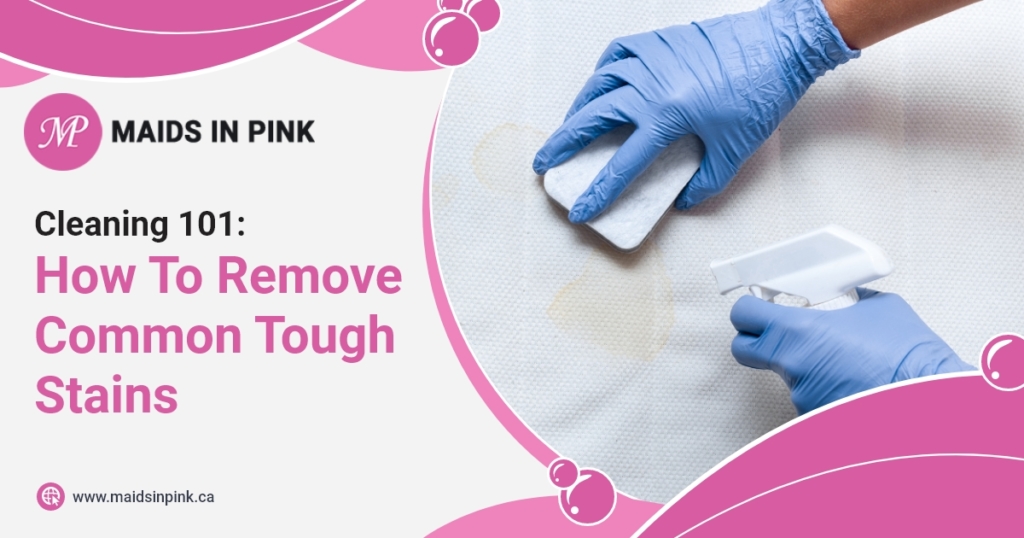Whether they’re on furniture or clothes, dealing with stains is one of the most common cleaning issues people face. Although some blemishes are easy to tackle, others are trickier than a Rubik’s Cube, requiring unique strategies or an extra dose of time and elbow grease.
Let us save you from the trouble of thinking about how to deal with those tough spots. Check out which are the most common stubborn stains and the best ways to bid them farewell.
Before you jump in
It is important you know that using the wrong water temperature can affect your work, potentially mucking up the removal process or, worse, wrecking the surface you’re dealing with.
Delicate fabrics like satin, silk, or wool can get damaged if you don’t use cold water. Also, don’t even think about hitting organic stains with hot water—it could make them get permanently set into some fabrics and surfaces.
Extra: If you’re unsure about a fabric, do a quick check of the washing instructions on the label.
Red wine
If you accidentally baptize your carpet or clothes with red wine, quick action is your trusty sidekick! Try this out:
Whip up a DIY cleaner using one part hydrogen peroxide and two parts water. Then, slap on the mixture along with a bit of enzymatic laundry soap. Three minutes later, toss it in the washing machine with cold water and the same soap.
No washing machine nearby? Apply the hydrogen peroxide mix directly, wait three minutes, give the stain a gentle massage, and rinse with cold water.
Tomato sauce
Tomato stains play hard to get, leaving a quick mark. When you spot one, grab a spoon or dinner knife and scrape off any residue pronto.
Next, scrub the stain by hand using laundry soap, dishwashing liquid, or hand soap. Finally, rinse thoroughly with cold water.
Pro-tip: If possible, throw the stained item in the laundry with cold water and enzymatic detergent.
Grass or plant
Tackling grass stains can be a chore because chlorophyll—which gives plants their characteristic green color—acts like a dye, becoming one with your threads.
Bring them down by slathering on a mix of one part baking soda and hydrogen peroxide blended with three parts warm water. Let it cool for about ten minutes, then hand wash or throw it in the machine with your regular detergent.
Organic stains
Pet owners lend an ear! This method is your lifesaver for dealing with the unpleasant trio of urine, feces, and vomit stains. Here’s the lowdown:
Firstly, snag an enzymatic cleaner. These nifty products use friendly bacteria to chow down on stains. Apply it directly, follow the label’s orders, and remember that hot water is a big no-no!
Pro-tip: For bloodstains, make sure your cleaner has proteases as a component.
Paint and ink blots
Paint and ink are designed to set pretty well into the surfaces you use them, so, understandably, these stains are hard to remove. They rapidly permeate different surfaces, so you need to act as fast as you can on them.
Handle them delicately with rubbing alcohol, spreading it with a soft cloth and working it into the stain. Rinse with cold water, repeat a couple of times, and cap it off with a heavy-duty laundry detergent wash.
What if the stain is playing hard to get?
When going head-to-head with stains, speed is the name of the game. Even the most stubborn ones can throw in the towel over time, no matter how vigorously you scrub.
If you’re in a tug-of-war with those clingy stains, don’t go overboard. Too much effort could backfire, potentially causing harm to the fabric or surface you’re trying to rescue. However, if you’re feeling daring, proceed with caution!
Looking for more cleaning tips? We got them!
If you want to learn more tips on how to tackle other common cleaning chores, Maids In Pink has what you need. From how to get rid of bad odors in your home to tips to clean your upholstery, our blog is bursting with expert advice to elevate your cleaning game. Check it out!
